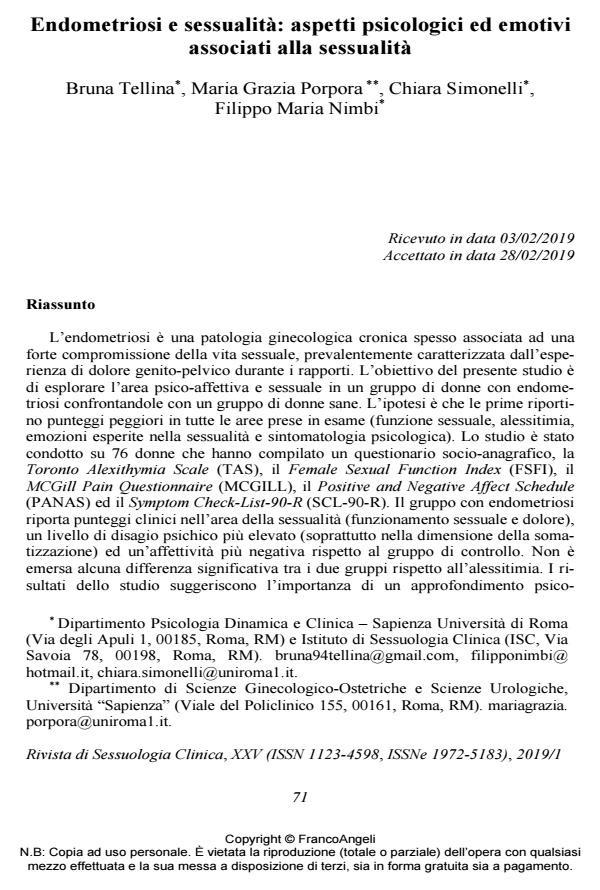Endometriosis and sexuality: psychological and emotional aspects associated to sexuality
Journal title RIVISTA DI SESSUOLOGIA CLINICA
Author/s Bruna Tellina, Maria Grazia Porpora, Chiara Simonelli, Filippo Maria Nimbi
Publishing Year 2019 Issue 2019/1
Language Italian Pages 15 P. 71-85 File size 183 KB
DOI 10.3280/RSC2019-001004
DOI is like a bar code for intellectual property: to have more infomation
click here
Below, you can see the article first page
If you want to buy this article in PDF format, you can do it, following the instructions to buy download credits

FrancoAngeli is member of Publishers International Linking Association, Inc (PILA), a not-for-profit association which run the CrossRef service enabling links to and from online scholarly content.
Endometriosis is a chronic gynecological disease often associated with a strong impairment of sexual life, mainly characterized by the experience of genital-pelvic pain during intercourses. The literature highlighted that endometriosis mainly af-fects the female reproductive system and therefore has a strong impact on sexuali-ty, on gender identity, on the quality of a woman’s relational and mental life. The present study arises from the intention to deepen the psycho-affective health situ-ation of women with endometriosis. The overall goal is to explore the characteris-tics associated with psycho-affective and sexual health in a small group of women with endometriosis by comparing it with a group of healthy women. The general hypothesis is that endometriosis women would report worse scores in all the areas examined (sexual function, alexithymia, emotions endorsed during sexual activity and psychological symptoms). Data were collected in two groups of women: 35 patients in child-bearing age (age range 18-45 years, M = 34.83, SD = 7.70) with a diagnosis of endometriosis (verified by laparoscopy) belonging to the department of Gynecology and Obstetrics of the Policlinico Umberto I and 41 healthy women from the general population. All women completed a socio-demographic ques-tionnaire, the Toronto Alexithymia Scale (TAS), the Female Sexual Function In-dex (FSFI), the MCGill Pain Questionnaire (MCGILL), the Positive and Negative Affect Schedule (PANAS) and the Symptom Check-List-90-R (SCL-90-R). In the results, the group with endometriosis reported clinical scores in the area of sexuali-ty (overall sexual functioning and pain), a higher level of psychological distress (especially in the somatization dimension) and a more negative emotions endorsed during sexual activity compared to the control group. Surprisingly, there was no significant difference between the two groups regarding to alexithymia. Although there are no significant differences between the two groups in this dimension, how-ever, women with endometriosis showed a light tendency to report greater difficul-ty in identifying feelings. The presence of alexithymia might represent a defense mechanism against mental and physical pain that should be better deepened in future studies. Chronic diseases involve a series of bodily, affective and cognitive transformations that force the individual to a radical existential change and an identity redefinition. The results obtained are in line with the data in the literature that testify the tendency of people suffering from chronic diseases to translate their internal conflicts through somatic symptoms. Women with endometriosis usually show passive and avoidant coping, negative emotions associated with poor mental status, and this is important to be considered for clinical purposes. This study further confirms how endometriotic pathology can have important re-percussions, as well as on the body, even in the psycho-affective and sexual sphere of the women affected. A profile emerged of women suffering and tending to somatization and a greater experience of negative emotions associated with sexual suffering. The literature suggests that a biopsychosocial approach, which places the woman to the center of a system and takes into account the psycholog-ical, biological and social variables in play, may be the most suitable for coping with the complexity of endometriosis. A model of this type is inspired by an inte-grated approach to the individual, the couple and the disease. Finally, it is im-portant to remember that the analysis of the problem from a psycho-sexological point of view as well as a physiological one, with particular attention to the diag-nosis and treatment phases, could result in an improvement of the assistance ser-vices and a higher probability of therapeutic success in the endometriosis patholo-gy.
Keywords: Endometriosis, sexuality, pain, affectivity.
Bruna Tellina, Maria Grazia Porpora, Chiara Simonelli, Filippo Maria Nimbi, Endometriosi e sessualità: aspetti psicologici ed emotivi associati alla sessualità in "RIVISTA DI SESSUOLOGIA CLINICA" 1/2019, pp 71-85, DOI: 10.3280/RSC2019-001004